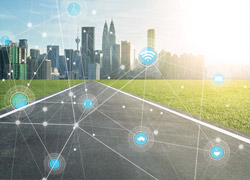Smart transportation is one of the areas in which Internet of Things (IoT) deployments can achieve measurable impacts on consumers’ lives and enable transport and city authorities to make substantial cost savings. George Malim explores how projects are being approached and what barriers remain to be overcome
The benefits to transport and city authorities that IoT can deliver appear obvious. Greater visibility into traffic flows and passenger demand patterns enables authorities to plan more effectively and deliver transport capacity to handle peaks in demand, while also ensuring excess capacity isn’t provisioned and therefore saving money. The clear business case is attracting organisations of all types to the early smart city transportation projects with several different types of project being prioritised.
“The Internet of Things (IoT) is going to completely revolutionise transportation in our cities, with intelligent buses, smart trains, hightech tube trains and connected cars all set to transform urban commuting and moving around cities from a high power, high emission task to an economically and environmentally friendly experience,” says Paul Bradley, the 5G strategy and partnerships director at Gemalto. “While the prospects are exciting, security and safety need to be addressed as primary components. This means that for any and every manufacturer that is looking to develop smart cars and smart transport networks, security must be at the forefront of their mind. In the race to add connectivity to cars and to develop intelligent IoT-driven transport networks, there is often the danger that manufacturers, developers and public transportation executives could be overlooking digital security, at the design point where it’s most important.”
Others share Bradley’s security and safety concerns. “Developing a smart transport network is the first step in the creation of a smart city, but it is not without its challenges,” says Martin Williams, the managing director of COPA-DATA UK. “In recent years, we have seen a barrage of media coverage condemning the cyber security aptitudes of Internet of Things (IoT) technology as inadequate. For large infrastructures, like a smart rail network, increased visibility is critical. Strong network encryption, user management and unique security mechanisms are just a few required security features – without neglecting the requisite of transparency for the user.”
Security and safety concerns are so significant because transportation initiatives will become so integral to our everyday lives. Therefore ensuring citizen safety is a paramount requirement.
“Technology is transforming how we live, and integral to this transformation are cities and their transport infrastructures,” says Norman Frisch, the marketing director for the Enterprise Business Group and Transport sector at Huawei. “From design through to integration, operations, service applications and infrastructure, cities are increasingly relying on ICT to inform, analyse and apply key data to keep people safe and to enable more efficient use of resources and convenience for citizens and organisations.”

“ICT in transport is a key component for smarter cities, not only to maximise safety but also because the drive for urbanisation and globalisation calls for improved networks between and within cities,” adds Frisch, who believes that deployment of train-to-ground 4G/LTE communications will provide far greater capabilities than the GSM-R infrastructure currently used by the railway industry. “Already today, key technologies such as 4G, cloud computing, machine-to-machine learning and operations are implemented in new projects and are going to become more commonly applied to transport systems such as railways, providing efficient passenger and freight services all across the globe,” he says.
Bradley looks further ahead and sees 5G wireless communications and other IoT-specific forms of connectivity enabling far richer experiences. “Embedded LTE solutions are playing a key role in car manufacturers being able to offer highspeed, low latency connectivity, as well as on the road experiences,” he says. “The next evolution of mobile data, 5G, will mark the giant step towards creating a truly connected world.”
“The technology has the potential to drive a new wave of ubiquitously connected gadgets and power the smart city of the future with a combination of customised connectivity bearers including low power wide area radio, but that’s not all,” adds Bradley. “It has the potential to provide ultra-reliable communications for connected and driverless vehicles or enabling reliable real-time detection and automation in smart factories, allowing fleets of robots to be controlled remotely.”

Others are looking beyond network connectivity and to emerging technologies to maximise the potential of smart transportation applications. “At present, smart cities are largely focused on data collection through sensors,” says Vishal Chatrath, the chief executive of Prowler.io. “The next stage is introducing artificial intelligence (AI) that uses this data to enable city planners to make informed decisions.”
“However, this needs to go beyond AI as we typically know it, which is based on limited decision trees, which follow if-this-then-that principles,” he adds. “This is fine for predictable situations, but challenges are presented when an AI bot is faced with a new scenario. It’s impossible to predict every possible scenario that could occur for every micro-movement across a city, in real-time. Reinforcement learning, combined with multi-agent behaviour introduces a previously unforeseen level of sophistication to AI.”
The reasons behind market enthusiasm for smart city transportation initiatives are several-fold and extend from enabling better planning to achieving environmental targets, saving costs and creating benefits for citizens.
“The leading cause of the world’s air pollution, and a significant contributor to global warming is transport, with vehicles emitting millions of pounds of hazardous pollutants into the air each year,” says Bradley, looking to the benefits of improving safety and minimising the environmental impacts of vehicles. “Driving can be dangerous as well – every year, between 20 and 50 million people suffer road traffic injuries globally, costing nations an estimated 3-5% of their gross national product.”
Chatrath has similar views. “Initiatives in the UK, such as introducing another runway at Heathrow Airport, roadworks, the introduction of Crossrail, or pedestrianising Oxford Street, can have a significant impact so simulations are required to test the impact,” he says. “Similarly, simulations can be set up to allow homeland security teams to identify weak points. Adding a layer of smart AI boosts the accuracy of these simulations and provides them with the ability to learn instantly from new data. The ability to make decisions based on sparse data, also means reactions can take place in real-time – essential when responding to a threat or an unexpected event.”
The large number of valuable applications that smart transportation technologies can enable and the insights those in turn can provide to smart cities explain the enthusiasm for smart transport applications. The good news is that current technologies are enabling organisations to start their initiatives and innovations such as AI, which are in the pipeline, will be integrated to enable further value to be added for future iterations.










